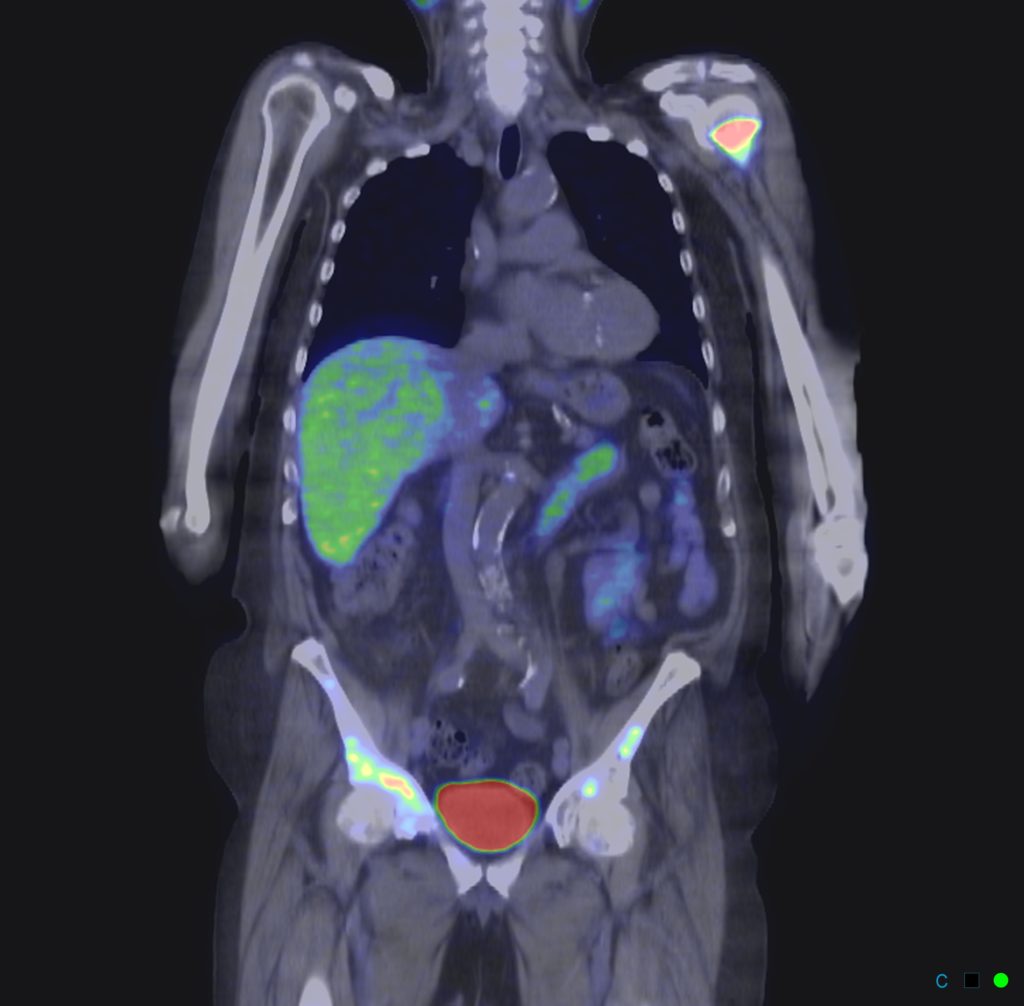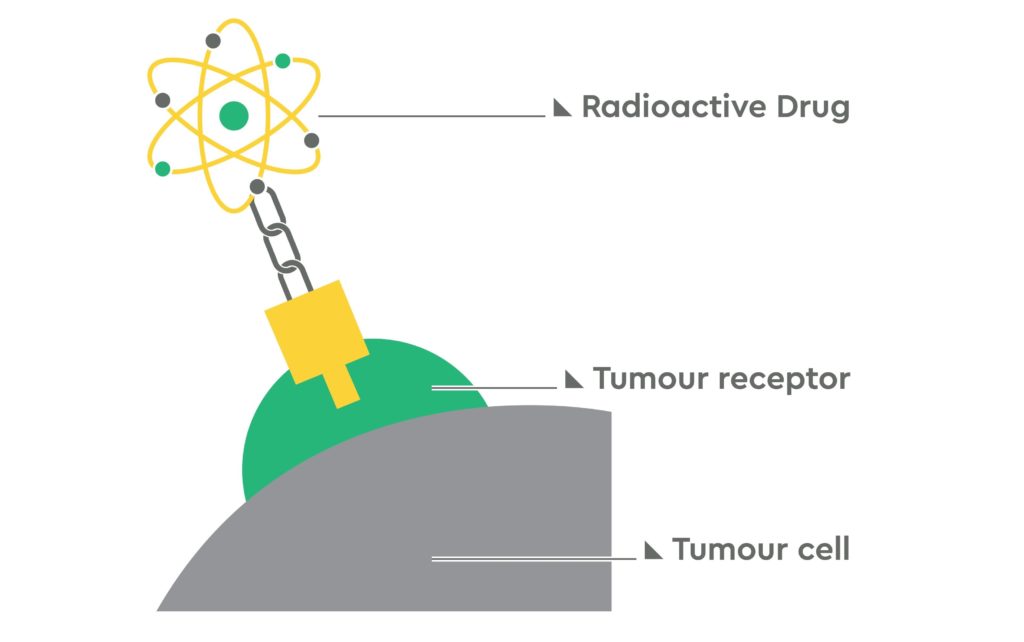Cancer remains one of the biggest causes of death in Australia. This year alone, an estimated 50,000 people nationwide will lose their lives to this complex and multifaceted disease – that’s about 140 of us each and every day.
Though the global and decades-long battle against cancer is seeing success, with increased survival rates in cancer patients overall, many forms of cancer remain incredibly difficult to treat.
We’re working hard to change that.
Through a new partnership with one of Australia’s largest cancer care providers and an emerging area of science called theranostics, we’re working to develop new therapies to fight even the most ‘untreatable’ cancers, and trial them right here in Australia.

A PET scan shows metastasised prostate cancer cells glowing in red in the shoulder and pelvis from the specially designed theranostic “homing missiles”. (Image: GenesisCare)
New treatments, faster
On the whole, cancer survival rates have improved, but people diagnosed with the most lethal forms of cancer — such as pancreatic and lung cancer — still have less than a one in five chance of surviving at least five years after their diagnosis. In fact, these types of cancers cause more than half of all cancer-related deaths.
Those who have metastatic cancer (where their cancer has spread to other parts of their bodies) face a similar distressing prognosis with very little available to them in terms of treatment.
Our new partnership with GenesisCare — one of the country’s largest cancer care providers — is powering the research we need to bring new, highly targeted therapies to patients suffering from some of the most fatal types of cancers including brain, pancreatic, ovarian cancer and metastatic cancers.
Our work with GenesisCare means that Australians will get access to any new therapies that are developed before the rest of the world because clinical trials will be based in Australia.
So, what sets theranostics apart from conventional cancer treatments?

The specially designed molecules, carrying a radioactive drug, seek out and attach themselves to unique cell signatures (‘tumour receptors’) on the surface of the cancer cells. The radioactive drug can then attack the cancer cell. (Image: GenesisCare)
Therapy + diagnostics = theranostics
Conventional cancer treatments today typically take a ‘one-size-fits-all’ approach; that is, patients receive the same treatment as others who have the same type and stage of cancer. But people can respond very differently to the same treatment, and its success varies.
That’s where theranostics comes in. Theranostics is a type of precision medicine which can be used to provide highly targeted cancer treatment, using molecular level diagnostics and therapy to find and attack individual cancer cells in a person’s body, leaving the neighbouring healthy cells alone. This is quite unlike systemic cancer treatments such as traditional chemotherapy, which can attack both cancerous and healthy cells, often causing debilitating side-effects for the patient.
Our scientists will be working to discover the unique signatures that are present for the cancer types we’re looking to treat, and then design special molecules to find and attach themselves to those cells. These molecules can then show us exactly where the cancer is located in the body, and deliver radiation directly to the cancer cells.
You can think of these molecules as ‘homing missiles’ that find and latch onto cancerous targets, allowing for highly targeted drug delivery.
You may not know it, but theranostics is already being trialled to better treat prostate and neuroendocrine cancers —with a rapidly developing body of evidence.

Specially designed molecules (‘targeting ligand’) seek out specific cancer cells. If they carry a diagnostic (1) they can show the exact location of the cancer cells in a scan, or if they carry a radioactive treatment (2) they can deliver the treatment straight to the cancer cell. (Image: GenesisCare)
The future of health monitoring and treatment
This new project is one of many we’re working on as part of our Probing Biosystems Future Science Platform: a multi-year, multi-disciplinary investment in our collective future, through devices and systems for real-time health and well-being monitoring.


16th May 2019 at 11:08 pm
This is wonderful news and offers great hope for the future. It might come too late for me, but please add renal cancer (clear cell carcinoma which is 90% of renal cancers) to your list. It does not seem to be a ‘featured cancer’ in the news or in research circles – even the Kidney Foundation doesn’t mention it! Perhaps it’s not sexy enough, or perhaps because it cannot be screened for and detected early, it doesn’t attract much funding.
I’m a Human Biologist and I didn’t spot any signs or symptoms until a high blood calcium level was found on a routine 3-monthly blood test – by which time it occupied 2/3 of my right kidney and was stage 4 having spread to some lymph nodes. It is very difficult to detect earlier, so many cases are well advanced. There is no chemotherapy for renal cancer, only biological treatments (tyrosine kinase inhibitors) which can be effective but I can testify to side effects equivalent to chemo except we need to take them all the time! Immunotherapy coming onto the PBS for RCC was welcome in terms of no side effects but wasn’t overly helpful for me. It slowed growth of my lung mets but did not shrink them. Then two new mets appeared on my liver so I was no longer within the protocols for immunotherapy.
Something targeted like theranostics is likely to make a huge difference to renal cancer patients, particularly stage 4 whose 5 year survival rate is variously reported as being from 8-22%. As a scientist that made very sobering reading, but at least I was able to have surgery so I did not die within weeks, not months, which was my prognosis at diagnosis. I’m actually doing remarkably well, being 7 weeks from my 4-year anniversary, but I am still taking TKIs for as long as I can till the side effects force me to take a break and that’s not easy to live with, I have 5 mets which is not a heavy load and gives me some cause for hope as it has been over a year since any new ones were detected, However, being immunocompromised, my major concern is avoiding respiratory infections this year. I had two bouts of pneumonia last year, from the second of which (the doctor now tells me) ‘I almost died’. On the chance I make it past my 5 years but still have mets to deal with … I’d be very happy to trial theranostics!
I sincerely wish you all the very best success with your research.
16th May 2019 at 10:35 pm
I have had the diagnostic theranostics done on my prostate cancer and the chemotherapy treatment has been successful but has really done damage to my body. I hope this new theranostic treatment will be available when I need it.
16th May 2019 at 2:33 pm
Sounds wonderful. Are you at the stage of a preliminary clinical trial yet, and, if so, would prostate cancer be on your list?
17th May 2019 at 4:35 pm
Hi Jim, I believe theranostics trials for prostate cancer are already underway (although not directly connected this project, as this is just starting to work to develop theranostics treatments for the other cancers listed in this blog). Please contact our partner GenesisCare for more information: visit their website http://www.genesiscare.com/au/treatment/cancer/theranostics/ email theranosticsreception@genesiscare.com.au, or phone +61 8 9438 8500.
Kind regards,
Kashmi
CSIRO Social Media Team
16th May 2019 at 1:38 pm
As someone who lost my wife almost 3 years ago to cervical cancer and currently diagnosed with prostate cancer ( and currently waiting scans to see if its spread) this news is one of HOPE for all that are afflicted with any kind of Cancer. it also makes me proud to be part of this wonderful Organisation.
Bob
16th May 2019 at 12:14 pm
A wonderful advancement, with such incredible potential!!! Every success to all involved